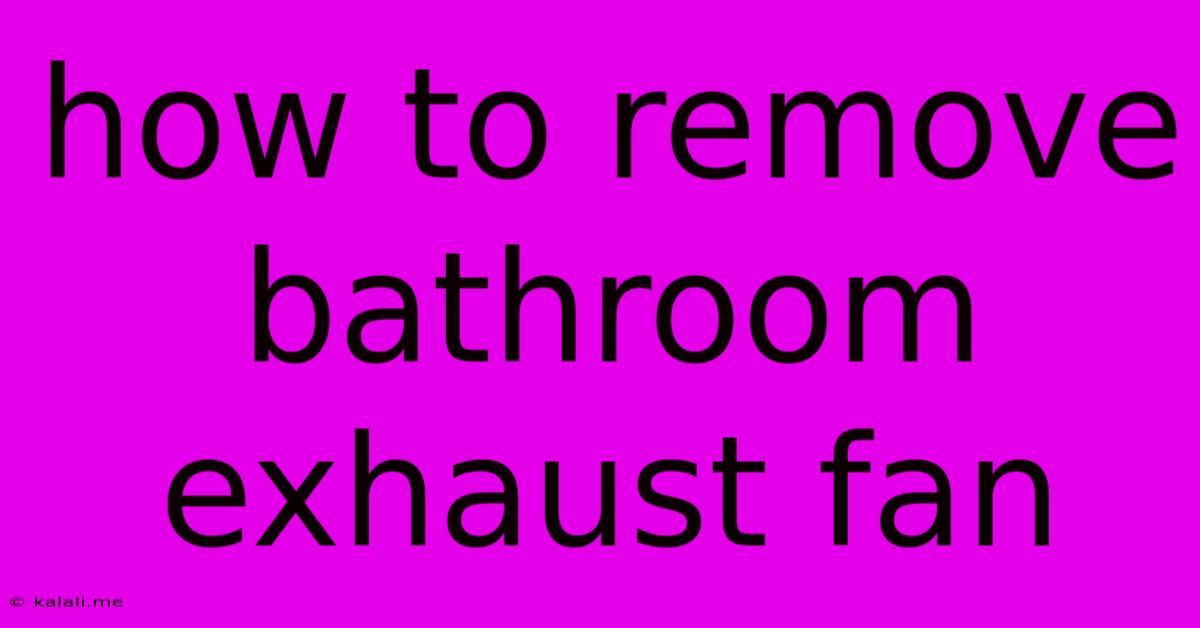How To Remove Bathroom Exhaust Fan
Kalali
May 27, 2025 · 3 min read

Table of Contents
How to Remove a Bathroom Exhaust Fan: A Step-by-Step Guide
Meta Description: Learn how to safely and efficiently remove your bathroom exhaust fan with our comprehensive step-by-step guide. We cover everything from turning off the power to disconnecting wiring and removing the fan housing. Improve your bathroom ventilation knowledge today!
Replacing a faulty bathroom exhaust fan is a common DIY home improvement project. A malfunctioning fan can lead to moisture buildup, mold growth, and unpleasant odors. This guide provides a detailed walkthrough on how to safely remove your existing fan, preparing you for installation of a new one. Remember, always prioritize safety and turn off the power before starting any electrical work.
Tools and Materials You'll Need:
- Screwdriver: Phillips and flathead, depending on your fan's screws.
- Voltage Tester: Crucial for ensuring the power is completely off.
- Wire Strippers/Cutters: If you need to cut or strip wires.
- Electrical Tape: To secure wire connections.
- Ladder: To safely reach the fan.
- Safety Glasses: Protect your eyes from debris.
- Optional: Work gloves: To protect your hands.
Step 1: Turn Off the Power
This is the most crucial step. Locate your electrical panel and switch off the breaker controlling the bathroom exhaust fan. Double-check that the power is off by using a voltage tester on the wires connected to the fan.
Step 2: Remove the Fan Cover
Most bathroom exhaust fans have a cover held in place by screws. These screws are usually located on the sides or top of the fan cover. Use your screwdriver to carefully remove these screws. Once removed, gently detach the cover and set it aside. Be mindful of any fragile components.
Step 3: Disconnect the Wiring
Carefully inspect the wiring connected to the fan. You'll typically find two or three wires: a black (hot), white (neutral), and possibly a green or bare copper wire (ground). Before disconnecting, take a picture of the wiring configuration to ensure correct reconnection during installation. Use your wire strippers/cutters to carefully disconnect the wires from the fan. Note the color coding and which wire goes where.
Step 4: Remove the Fan Housing
The fan housing is usually secured to the ceiling with screws. These screws might be visible, or they may be hidden behind decorative trim. Locate and remove these screws. Gently lower the fan housing. Be cautious as it may be heavier than anticipated. You may need an extra set of hands for support.
Step 5: Disconnect the Ductwork
The exhaust fan is connected to a duct that vents air outside. Carefully disconnect the ductwork from the fan housing. This might involve loosening clamps or removing other fasteners. If the ductwork is flexible, it should be relatively easy to disconnect. For rigid ductwork, you might need additional tools.
Step 6: Remove the Fan Motor
Once the housing is removed, you should have access to the fan motor itself. Disconnect any remaining wires attached to the motor. The motor might be screwed into the housing, or it could simply be clipped in place. Remove the motor according to the manufacturer's instructions or your observations.
Step 7: Clean Up and Dispose of Old Fan
After removing the exhaust fan, clean the area of any debris or dust. Properly dispose of the old fan according to your local regulations. Recycle components where possible.
Important Safety Considerations:
- Always turn off the power before working on any electrical appliance.
- Use a voltage tester to confirm the power is off.
- Never work on wet or damp surfaces.
- Wear safety glasses to protect your eyes from debris.
- Use a ladder if you need to reach the fan safely.
- If you're uncomfortable with any step of this process, consult a qualified electrician.
This guide provides a general overview; the exact steps may vary slightly depending on your specific bathroom exhaust fan model. Always refer to the manufacturer's instructions for detailed guidance. Remember, safety should be your top priority!
Latest Posts
Latest Posts
-
How Do You Write A Negative Dollar Amount
May 29, 2025
-
How To Fix Stripped Threads In Aluminum
May 29, 2025
-
Toilet Bowl Filling Up With Water
May 29, 2025
-
Sd Card Not Showing Up Mac
May 29, 2025
-
What Is It Called When You Blow On Someones Stomach
May 29, 2025
Related Post
Thank you for visiting our website which covers about How To Remove Bathroom Exhaust Fan . We hope the information provided has been useful to you. Feel free to contact us if you have any questions or need further assistance. See you next time and don't miss to bookmark.